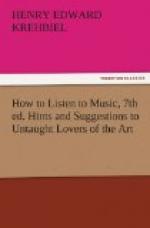So writes Dr. Stainer, and it is his emotionalist against whom I uttered a warning in the introductory chapter of this book, when I called him a rhapsodist and described his motive to be primarily a desire to present himself as a person of unusually exquisite sensibilities. Frequently the rhapsodic style is adopted to conceal a want of knowledge, and, I fancy, sometimes also because ill-equipped critics have persuaded themselves that criticism being worthless, what the public need to read is a fantastic account of how music affects them. Now, it is true that what is chiefly valuable in criticism is what a man qualified to think and feel tells us he did think and feel under the inspiration of a performance; but when carried too far, or restricted too much, this conception of a critic’s province lifts personal equation into dangerous prominence in the critical activity, and depreciates the elements of criticism, which are not matters of opinion or taste at all, but questions of fact, as exactly demonstrable as a problem in mathematics. In musical performance these elements belong to the technics of the art. Granted that the critic has a correct ear, a thing which he must have if he aspire to be a critic at all, and the possession of which is as easily proved as that of a dollar-bill in his pocket, the questions of justness of intonation in a singer or instrumentalist, balance of tone in an orchestra, correctness of phrasing, and many other things, are mere determinations of fact; the faculties which recognize their existence or discover their absence might exist in a person who is not “moved by concord of sweet sounds” at all, and whose taste is of the lowest type. It was the acoustician Euler, I believe, who said that he could construct a sonata according to the laws of mathematics—figure one out, that is.
[Sidenote: The Rhapsodists.]
[Sidenote: An English exemplar.]
Because music is in its nature such a mystery, because so little of its philosophy, so little of its science is popularly known, there has grown up the tribe of rhapsodical writers whose influence is most pernicious. I have a case in mind at which I have already hinted in this book—that of a certain English gentleman who has gained considerable eminence because of the loveliness of the subject on which he writes and his deftness in putting words together. On many points he is qualified to speak, and on these he generally speaks entertainingly. He frequently blunders in details, but it is only when he writes in the manner exemplified in the following excerpt from his book called “My Musical Memories,” that he does mischief. The reverend gentleman, talking about violins, has reached one that once belonged to Ernst. This, he says, he sees occasionally, but he never hears it more except
[Sidenote: Ernst’s violin.]
“In the night ... under the stars, when the moon is low and I see the dark ridges of the clover hills, and rabbits and hares, black against the paler sky, pausing to feed or crouching to listen to the voices of the night....
“By the sea, when
the cold mists rise, and hollow murmurs,
like the low wail of
lost spirits, rush along the beach....




